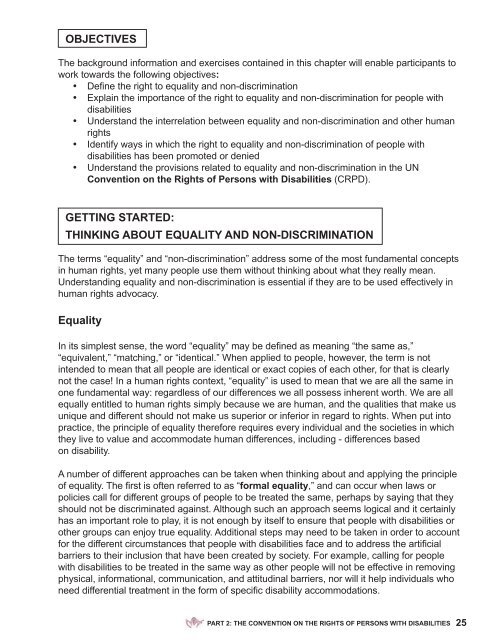Full page photo print - Harvard Law School Project on Disability
Full page photo print - Harvard Law School Project on Disability
Full page photo print - Harvard Law School Project on Disability
Create successful ePaper yourself
Turn your PDF publications into a flip-book with our unique Google optimized e-Paper software.
obJecTives<br />
The background informati<strong>on</strong> and exercises c<strong>on</strong>tained in this chapter will enable participants to<br />
work towards the following objectives:<br />
• Define the right to equality and n<strong>on</strong>-discriminati<strong>on</strong><br />
• Explain the importance of the right to equality and n<strong>on</strong>-discriminati<strong>on</strong> for people with<br />
disabilities<br />
• Understand the interrelati<strong>on</strong> between equality and n<strong>on</strong>-discriminati<strong>on</strong> and other human<br />
rights<br />
• Identify ways in which the right to equality and n<strong>on</strong>-discriminati<strong>on</strong> of people with<br />
disabilities has been promoted or denied<br />
• Understand the provisi<strong>on</strong>s related to equality and n<strong>on</strong>-discriminati<strong>on</strong> in the UN<br />
c<strong>on</strong>venti<strong>on</strong> <strong>on</strong> the Rights of Pers<strong>on</strong>s with disabilities (CRPD) .<br />
geTTing sTARTed:<br />
ThinKing AbouT eQuAliTy And n<strong>on</strong>-discRiminATi<strong>on</strong><br />
The terms “equality” and “n<strong>on</strong>-discriminati<strong>on</strong>” address some of the most fundamental c<strong>on</strong>cepts<br />
in human rights, yet many people use them without thinking about what they really mean .<br />
Understanding equality and n<strong>on</strong>-discriminati<strong>on</strong> is essential if they are to be used effectively in<br />
human rights advocacy .<br />
equality<br />
In its simplest sense, the word “equality” may be defined as meaning “the same as,”<br />
“equivalent,” “matching,” or “identical .” When applied to people, however, the term is not<br />
intended to mean that all people are identical or exact copies of each other, for that is clearly<br />
not the case! In a human rights c<strong>on</strong>text, “equality” is used to mean that we are all the same in<br />
<strong>on</strong>e fundamental way: regardless of our differences we all possess inherent worth . We are all<br />
equally entitled to human rights simply because we are human, and the qualities that make us<br />
unique and different should not make us superior or inferior in regard to rights . When put into<br />
practice, the principle of equality therefore requires every individual and the societies in which<br />
they live to value and accommodate human differences, including - differences based<br />
<strong>on</strong> disability .<br />
A number of different approaches can be taken when thinking about and applying the principle<br />
of equality. The first is often referred to as “formal equality,” and can occur when laws or<br />
policies call for different groups of people to be treated the same, perhaps by saying that they<br />
should not be discriminated against . Although such an approach seems logical and it certainly<br />
has an important role to play, it is not enough by itself to ensure that people with disabilities or<br />
other groups can enjoy true equality . Additi<strong>on</strong>al steps may need to be taken in order to account<br />
for the different circumstances that people with disabilities face and to address the artificial<br />
barriers to their inclusi<strong>on</strong> that have been created by society . For example, calling for people<br />
with disabilities to be treated in the same way as other people will not be effective in removing<br />
physical, informati<strong>on</strong>al, communicati<strong>on</strong>, and attitudinal barriers, nor will it help individuals who<br />
need differential treatment in the form of specific disability accommodati<strong>on</strong>s.<br />
PART 2: The c<strong>on</strong>venTi<strong>on</strong> <strong>on</strong> The RighTs of PeRs<strong>on</strong>s wiTh disAbiliTies<br />
25




